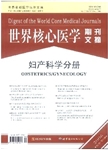盆腔淋巴结计数是FIGO分期Ⅰ期和Ⅱ期高危组织学类型子宫内膜癌患者的重要预后因子
Pelvic lymph node count is an important prognostic variable for FIGO stage Ⅰ and Ⅱ endometrial carcinoma with high-risk histology作者机构:Division of Gynecologic Oncology Department of Obstetrics and Gynecology Duke University Medical Center PO Box 3079 Durham NC 27710 United States
出 版 物:《世界核心医学期刊文摘(妇产科学分册)》 (Core Journal in Obstetrics/Gynecology)
年 卷 期:2006年第2卷第10期
页 面:47-48页
学科分类:1002[医学-临床医学] 100214[医学-肿瘤学] 10[医学]
主 题:盆腔淋巴结 FIGO分期 预后因子 肌层浸润深度 手术分期 无进展生存期 淋巴清扫 术后放疗 肿瘤复
摘 要:Objective.: To determine whether pelvic lymph node count is associated with patterns of recurrence or survival in patients with FIGO stage I and II endometrial cancer. Methods.: Single institution retrospective study of 467 patients with FIGO stage I and II endometrial cancer treated with primary surgery including lymph node dissection. Analysis included pelvic lymph node count, histology, stage, age, race, BMI, year of surgery, depth of myometrial invasion, and adjuvant radiation. Kaplan-Meier life-tables were used to calculate survival; the Cox proportional hazards model was used to identify prognostic factors independently associated with survival. Results.: Mean pelvic lymph node count was 12.6(SD±8). Distant recurrence was associated with decreased pelvic lymph node count, high-risk histology, and postoperative pelvic radiation. Pelvic lymph node countwas not associated with survival by univariate analysis, however, overall(OS) and progression-free(PFS) survival were significantly better with pelvic lymph node counts ≥12 among women with high-risk histology(P 0.001), but not among women with low-risk histology. Multivariable Cox proportional hazards regression identified increasing age, non-Caucasian race, and high-risk histology as independent negative prognostic factors for both OS and PFI. Among patients with high-risk histology, pelvic lymph node count remained an independent prognostic factor for both overall(OS) and progression-free survival(PFS) in the model, with hazard ratios of 0.28 and 0.29, respectively, when ≥12 pelvic lymph nodes were identi-fied. Pelvic lymph node count had no association with OS or PFS in women with low-risk histology. Conclusion.: Pelvic lymph node count ≥12 is an important prognostic variable in patients with FIGO stage I and II endometrial cancer who have high-risk histology. Most likely, the association of survival and lymph node count in this group is the result of improved staging among patients with higher pelvic lymph n



